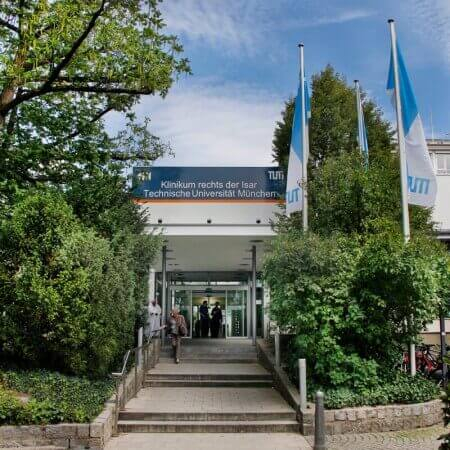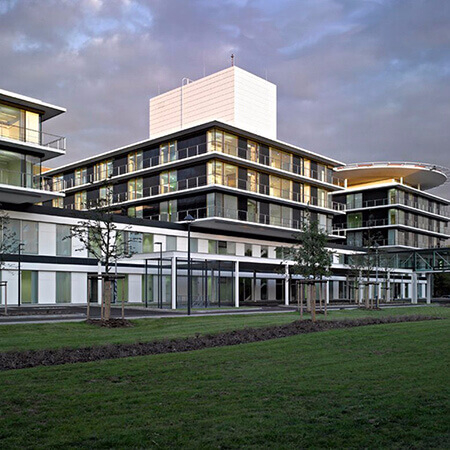Cataract
Due to the difficulties associated with the organization of treatment in Turkey, Switzerland, South Korea and India, we are not currently processing requests to these regions.
If you are interested in treatment in Germany, please leave a request and our specialists will contact you as soon as possible.
Cataract is a lens opacity that leads to the eventual loss of one’s vision. This condition is common among elderly people. According to different authors, the risk of the lens opacity is 60-90% after the age of 60. Approximately 50% of all blindness cases are caused by the cataract. This disease accounts for 35% of all ophthalmic surgeries in the world.
The Booking Health portal presents 46 German clinics specializing in cataract treatment
Show all clinics
Cataract – Diagnostics
The doctor reveals cataract during the examination of the eyes with passing light. Before the examination the pupil is dilated with the help of medicines. If there are some signs of cataract, pupils become black under pink light, since the reflected rays are partially absorbed by the opalescent fibres of the lens.
A biomicroscopic study using a slit lamp makes it possible to determine the location of the opacity foci as well as their prevalence. This diagnostic procedure allows the doctor to determine the decay degree of the lens fibre.
Following techniques assist a doctor while establishment, refinement and differential diagnostics:
- Assessment of vision acuity
- Tonometry (measurement of the intraocular pressure)
- Keratometry (measurement of the cornea anterior surface curvature)
- Ophthalmoscopy (examination of the fundus)
- Perimetry (definition of visual fields)
In certain clinical cases a specialist may also perform some other procedures, such as:
- Electrophysiological examination of the optic nerve
- Endothelial microscopy
- Ultrasound examination
- Definition of retinal visual acuity
Best clinics for the cataract diagnostics in Germany:
Cataract – Treatment
Conservative techniques aimed to slow down the process of lens opacity are constantly being developed. Nevertheless, taking into account the fact that cataract is able to progress within decades, there were no conclusive evidence proving the effectiveness of certain medicines yet.
Treatment is based on the surgical intervention. It is necessary to remove the affected lens and replace it with the artificial one to preserve vision. The following interventions are applied:
Extracapsular extraction of a cataract is a classic operation that has been used for many years. It is still used in the developing countries, although it has already been displaced in countries with more progressive healthcare and surgical techniques. The lens is removed together with the capsule, and then the intraocular lens (artificial lens) is inserted into its place.
Phacoemulsification of the lens is the most common operation for the cataract treatment in developed countries. It has a much lower risk of complications and higher efficacy. Intracapsular lens removal is performed. The doctor shreds it with an ultrasound and sucks up the liquid with a special device (phacoemulsifier). Then, the intraocular lens is inserted instead of the damaged one.
Such surgery has the following benefits:
- No sutures are required
- Short rehabilitation period
- Performed under local anaesthesia
- Short duration of the operation
- Low risk of complications
Cataract – Innovative treatment
Until recently, doctors had the opportunity only to install artificial intraocular lenses instead of affected ones. This was the essence of cataract surgical treatment, regardless of what kind of operation is carried out by an ophthalmologist.
In 2016 the research on growing own human lens from stem cells was completed successfully. This technique gives a chance to effectively treat congenital cataract in the newborns. It has not been applied for the senile cataract treatment, but it is going to be for sure.
The core of the technique is that damaged lens is removed and a new one is grown instead. Lens is grown from the stem cells, which are located at the same spot, inside the lens. Specialists had to change the way they performed a surgery of its extraction, as stem cells were removed together with the lens before.
Newborns had their vision completely restored within 3 months after the surgeries. Rejection of such a lens does not occur, because it is grown from autologous, genetically native cells.
Best clinics for the cataract treatment in Germany:

University Hospital Rechts der Isar Munich

University Hospital Duesseldorf

University Hospital Ulm
Author:
The article was edited by medical expert, board certified Dr. Nadezhda Ivanisova. For the treatment of the conditions referred to in the article you must consult a doctor; the information in the article is not intended for self-medication!
Sources:
International Council of Ophthalmology
The cost of services includes
Here you can find the cost of treatment for this disease at the German University Hospitals. Leave a request and we will provide a free consultation with a doctor and will start organizing the whole treatment process.
The program includes the following:
- Issuing of an invitation for getting a visa for treatment as quick as possible
- Fixing an appointment at a time convenient for you
- Preliminary organization of a comprehensive examination and discussion of the forthcoming treatment plan
- Arranging transfer from the airport to the hospital and back to the airport
- Provision of interpreting services and services of a personal medical coordinator
- If necessary, assistance in the organization of further surgical treatment
- Provision of a medical insurance against treatment complications covering up to 200,000 euro
- Preparation and translation of medical records and recommendations from the hospital
- Assistance in the subsequent communication with your attending physician, including consultations on repeated X-ray images through the unique medical document management system E-doc

